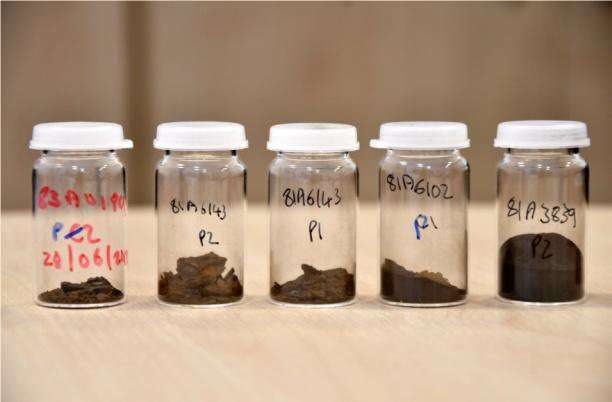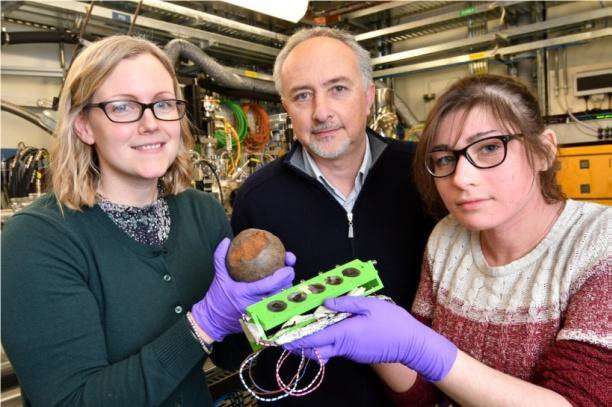The science of preserving Henry VIII's 1200+ cannonballs

In a ground-breaking partnership between The Mary Rose, UCL and Diamond Light Source, the Mary Rose's Head of Conservation, Dr. Eleanor Schofield and her colleagues are working at the cutting edge of conservation science to protect and preserve the huge haul of cannonballs found on Henry VIII's flagship. But in a contradictory twist, the only way to uncover how to preserve them is to sacrifice some of them.
Dr. Schofield explains: "This is conservation science at its most cutting edge. We have taken just 12 of the cannonballs—less than 1 percent of the Mary Rose's stock but enough to provide statistical validity of our findings—to investigate different methods of conservation through synchrotron science. Our cannonball sample is unique in that they were all raised from the sea at the same time, made at the same time, and are of very similar construction as only one iron blast furnace existed in Britain at the time of the Mary Rose's construction. This means that once we've found the solution, then the cannonballs can be preserved for generations to come and the science made available globally to all those whose conservation work involves maritime or iron-rich artefacts."
Dr. Schofield is working with Ph.D. student Hayley Simon from UCL Institute of Archaeology and Diamond Light Source. Diamond is the UK's national synchrotron and offers many non-destructive techniques that can be used to unlock the secrets of ancient treasures and explore ways to conserve artefacts ranging from ancient scrolls, bones, woods, paintings and materials to maritime treasures like The Mary Rose, the famous Tudor Ship sunk in 1545 and raised from the sea in 1982.
Seawater and iron are not compatible, causing corrosion that eats away at the metal and weakens its structure. Though the 1200+ cannonballs began as a relatively similar set, since excavation they have been treated by different conservation methods. Diamond's bright light X-rays make it possible to visualise the differences in the corrosion profiles and trace them to the treatments applied.
In a paper published today, the results of the bright X-rays have revealed detailed maps of the elements involved in the corrosive process. This allows an unprecedented insight into conservation on a molecular scale. This is crucial information that will help protect this cultural heritage for many decades to come.

With over 1,200 cannonballs, the search for a solution was imperative. Already much has been achieved through the research carried out at Diamond on the wood from the main ship, monitoring its treatment and current display environment and developing new conservation treatments. After consulting with Mary Rose curators, the decision was made in 2016 to cut segments from 6 of the 12 cannonballs, some of which were showing signs of damage, in order to save the rest.
Dr. Eleanor Schofield continues: "We knew that we needed to really delve into the material and find out what was going on, and that this would require destructive sampling. This decision was not taken lightly, and was justified by sacrificing a small percentage of our collection for the benefit of the rest and other collections around the world which suffer the same problem."
Hayley Simon, who is now part way through her Ph.D. adds: "These results represent a first step towards the development of new protective techniques. We are launching next a long duration experiment, which will observe changes in the corrosion product during long-term immersion in various conservation treatments to monitor their effects."
Dr. Schofield adds: "People often ask me what science has to do with the Mary Rose; the answer is 'everything'! Facilities like Diamond allow us to find ways of conserving ancient artefacts – we need the detail Diamond offers because this process often starts at the cellular, molecular and atomic levels. Science is a vital part of conservation, and it's great to know that we're playing our part in preserving our cultural heritage."
Prof Andrew Harrison, CEO of Diamond Light Source, states, "The breadth of science that takes place at Diamond is vast from developing vaccines to investigating new ways to store energy, and this study is a wonderful example of the kind of ground-breaking research that happens when unique institutions collaborate. Though only a small section of Diamond time is spent on cultural heritage, it is an important sector for the UK economy resulting in some £20 billion to the GDP. We are always delighted when Diamond's brilliant light can offer insights into remarkable artefacts, and assist the Mary Rose Trust in the valuable work they are doing to preserve our cultural heritage, allowing generations to enjoy for decades to come."
Dr. Sofia Diaz-Moreno, Science Group Leader of Spectroscopy, Diamond Light Source, concludes, "Learning about the effect of different conservation techniques on a sample allows conservationists to determine the best treatment to preserve an artefact for generations. At Diamond, we have a suite of techniques that can chemically determine the effectiveness of different treatments helping to elucidate new conservation methodologies. These techniques are not well known in the cultural heritage sector, nevertheless we have been in collaboration with the Mary Rose Trust for many years, first working on the preservation of the ship's wood and now investigating the optimum conservation treatments for the 1248 iron cannonballs."
More information: Hayley Simon et al. A Synchrotron-Based Study of the Mary Rose Iron Cannonballs, Angewandte Chemie International Edition (2018). DOI: 10.1002/anie.201713120
Journal information: Angewandte Chemie International Edition
Provided by Diamond Light Source




















